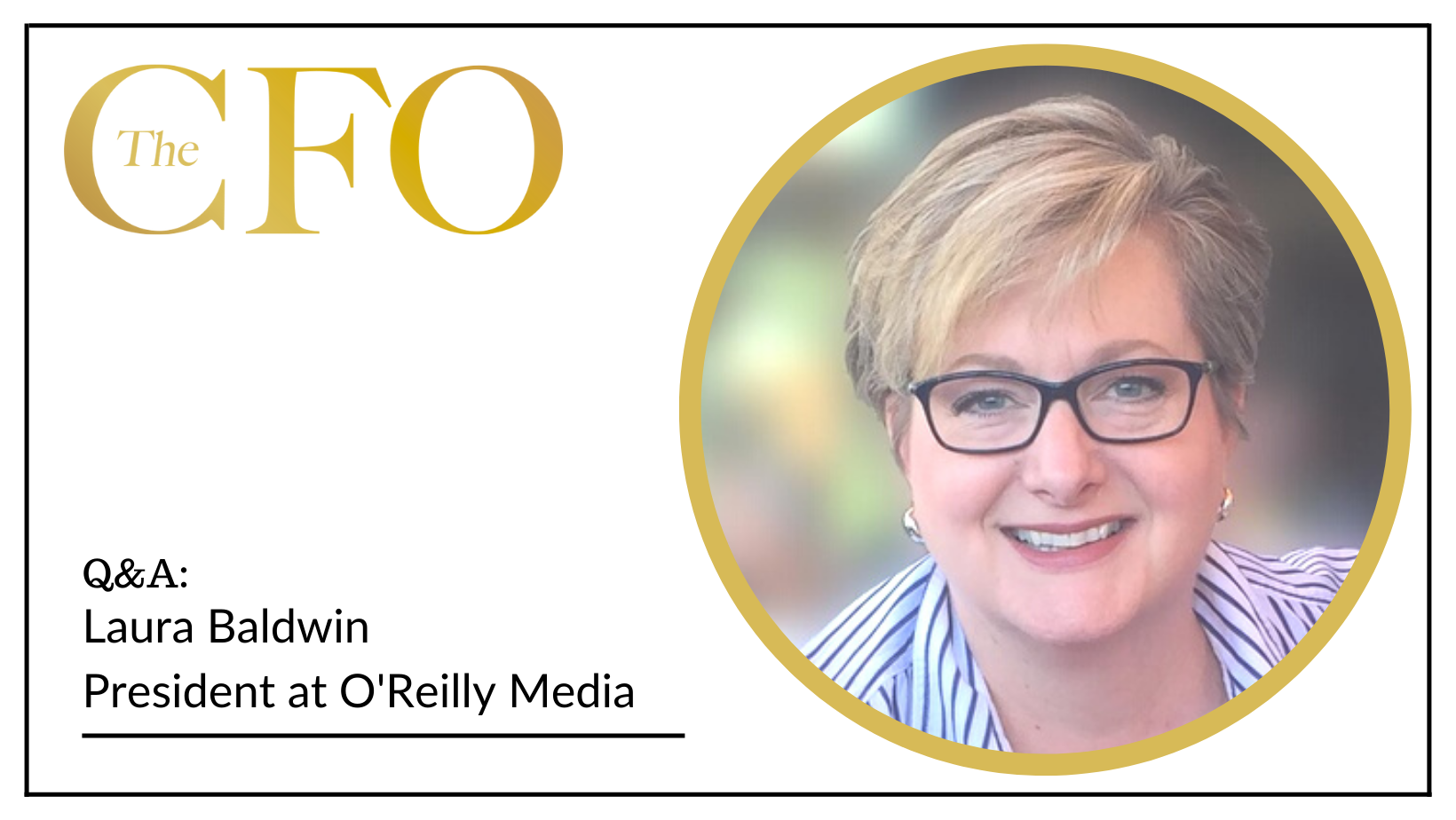Q&A: O’Reilly Media president on making the leap from CFO to CEO
The CFO spoke with Laura Baldwin, president at O’Reilly Media about making the move from the company’s senior finance leader to its chief executive
The CFO spoke with Laura Baldwin, president at O’Reilly Media about making the move from the company’s senior finance leader to its chief executive

Many CFOs at some point find themselves slipping into the role of a CEO. Their strategic mindset and financial acumen make them well placed in driving growth and navigating a company through turbulent times. In fact, 42% of CEOs in the FTSE 100 have a background in finance and banking, according to research by Robert Half.
However, the journey from CFO to CEO is not without its challenges. When Laura Baldwin made the jump at O’Reilly Media, she was met with pushback from her peers which forced her to modify her approach to leadership.
Speaking to The CFO, Baldwin shares her experience of making the jump from CFO to CEO and how she steered the company through a major transformation that saw the publisher become a digital learning platform.

In 2011, you became president of O’Reilly Media after previously working as its CFO and COO. What made you want to make the jump from CFO to CEO/president? Was it always part of your career path?
I started out in banking, which is where I learned how to marry my maths skills with process and business. From there I transitioned into roles in cash management and finance. It didn’t take long for me to understand that finance is really telling the story of the operational decisions made every day in service of the business—and I’ve immersed myself in the business operations of every company I’ve worked for. That personal curiosity around business decision-making and strategy development led me to my current role at O’Reilly.
I first joined the company as CFO, where I intentionally led the team through an operational lens. That resulted in promotions to COO and then president. I didn’t plan my career per se, but I always knew I wanted to be in a leadership position. When I was 29 years old, I remember thinking, “I want to be a CFO by the time I’m 35.” And it happened when I earned the title with Chronicle Publishing. But the rest of my career path has been a combination of my love of numbers and my natural curiosity.
How did your skills as a CFO prepare you and help you in your role as a CEO?
One of the operating principles I established when I became president was, “you cannot manage what you don’t measure.” I see the numbers as a storytelling device leaders can use to accurately weigh their operational decisions at every turn. And viewing them through that lens has consistently been my guiding light as I run O’Reilly.
In your experience, what was the hardest part of the transition from CFO to CEO?
The most difficult part for me was the same thing I see in anyone who’s promoted from within: moving from peer to manager. It’s a tough road to navigate, so it’s critical you do the necessary homework to develop a partnership with your new direct reports—in my case the people leading the company day-to-day. I had to prove to them I could drive the business and not just report on decisions. I was already part of the leadership team, so I was well on my way to establishing those working relationships. But I did go the extra mile to learn each of the team’s areas of expertise in a far deeper way than I had before. I couldn’t tell you how many marketing and branding books I read to educate myself, but there were a lot.
I also took over for an iconic founder (who by the way the entire company wanted to please). Trying to build a company strong enough to survive as he stepped away from day-to-day operations came with challenges and pushback against new ideas I didn’t anticipate. However, the experience taught me to trust my instincts and stay confident that I was making the right decisions for the organisation as a whole.
I’ve always framed my role as balancing an ecosystem of shareholders, customers, and employees. At times, the decisions that kept that ecosystem in balance emerged from listening and responding to that pushback. I still use the lessons learned during that time as the basis of how we think and operate as an organisation today.
O’Reilly has gone through multiple transformations in its time including pivoting from a technology textbook publisher to an online learning platform. What were some of the key lessons you learnt in that process?
First and foremost, you always have to view the market through the lens of the customer. What will your customers want as technology advances or conditions and needs change?
We’ve made multiple successful organisational pivots, and each was driven by customer feedback coupled with a healthy knowledge of where the market was going. We saw the decline in print books but knew our customers still craved the information. So we asked ourselves how we could bring our knowledge to them without printed pages, and we made it happen.
I wish there were some magic bullet or a formal process I could pass along. But as a leader, it’s more about dedicating yourself to staying educated on where your market is going. And it’s an ongoing process. Leveraging this knowledge to meet your customers’ needs is one of your top primary job responsibilities.
Given your experiences as a president/CEO, how would you suggest today’s CFOs should approach their role differently?
As I mentioned above, CFOs need to understand their job is storytelling. Too often I see CFOs who are all about the numbers, but they don’t provide the context in which those numbers can be used to make informed decisions. It’s imperative to have deep knowledge of the company’s strategic imperatives, then work to help their peers in sales, product, marketing, etc. align with those goals.
The CFO is a partner to each and every executive across departments and has to use the numbers to help those leaders make decisions, not thwart them. Decisions made only in service of the numbers, without a knowledge of why money is being spent (for example), can be short-sighted and frankly dangerous.
What advice would you give to other finance leaders looking to make the jump from CFO to CEO?
First, your people will only work as hard as you do – and leaders set the example more than they realise. I recall working in banking, and we had a Monday deadline for some contracts we were trying to close. I had a small team, and I left early on the Friday before our deadline. Even though I left instructions, my team didn’t have the sense of urgency they needed. We missed the deadline, which cost the bank a good amount of interest. It was awful at the time, but I’m grateful for having learned that lesson earlier in my career. To this day, I never ask nor expect anything from my team that I’m not willing to do myself.
Second, be a lifelong learner. Study the markets and the new approaches that arise for each discipline you manage, such as product or sales. Stay on top of technology, leadership trends, and your competitors.
Third, your people are your most valued asset. I’ve always run O’Reilly from what I call a “balanced ecosystem approach,” making decisions in service of our three constituencies: employees, customers, and shareholders. But it’s your team that drives the business forward.
To accomplish results, you need to be transparent about the company’s financial position, your strategy, and the context behind your decisions so they can see the future you’re trying to build and understand their place in it. Another operating principle we have is to be “tough on problems, not on people.” Everyone’s trying their best, but without a transparent and inclusive culture—without the support of your team—your strategy won’t see the light of day. Because it takes everyone to make the company a success.
To hear more on this topic, register for the CFO Executive Dialogue this October.